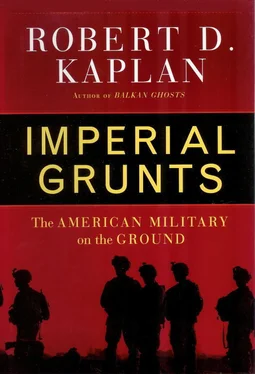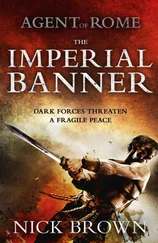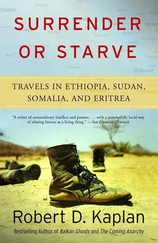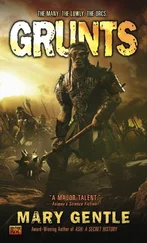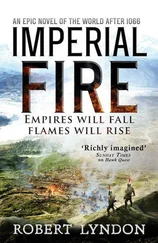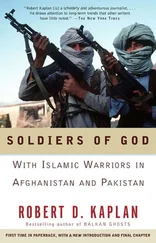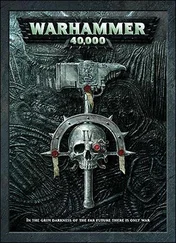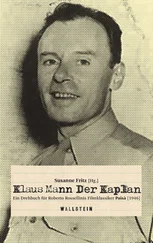38. Byron Farwell, Mr. Kipling’s Army: All the Queen’s Men (New York: Norton, 1981), p. 209.
Chapter 5—CENTCOM and SOCOM: Afghanistan, Autumn 2003
1. Michael R. Gordon and Gen. Bernard E. Trainor, The Generals’ War: The Inside Story of the Conflict in the Gulf (Boston: Little, Brown, 1995), p. xv.
2. Williamson Murray and Maj. Gen. Robert H. Scales Jr., The Iraq War: A Military History (Cambridge, MA: Harvard University Press, 2003), p. 248.
3. Amy Waldman and Dexter Filkins, “Two U.S. Fronts: Quick Wars but Bloody Peace,” New York Times, Sept. 19, 2003.
4. Max Boot, The Savage Wars of Peace: Small Wars and the Rise of American Power (New York: Basic Books, 2002), p. 293.
5. Lt. Col. David Maxwell, 1st Special Forces Group, unpublished paper, “How to Fight Counter-Insurgency.”
6. Robert D. Kaplan, “The Lawless Frontier: The Tribal Lands of the Afghanistan-Pakistan Border Reveal the Future of Conflict in the Subcontinent, Along with the Dark Side of Globalization,” The Atlantic Monthly, September 2000.
7. This and the following paragraphs draw heavily on my “Lawless Frontier” and my book on Afghanistan and Pakistan, Soldiers of God (Boston: Houghton Mifflin, 1990). See bibliography in Soldiers of God for more.
8. Olaf Caroe, The Pathans, 550 b.c.–a.d. 1957 (London: Macmillan, 1958), p. 255.
9. Kaplan, “Lawless Frontier.”
10. Robin Moore, The Hunt for Bin Laden: Task Force Dagger (New York: Random House, 2003), p. 5.
11. Ibid., p. 200.
12. W. J. Cash, The Mind of the South (1941; reprint, New York: Vintage, 1991), pp. 31–34, 38, 43–44, 121–122.
13. Louis Dupree, Afghanistan (Princeton, NJ: Princeton University Press, 1973, 1980), pp. 248–49.
14. C. E. Callwell, Small Wars: Their Principles and Practice (1896; reprint, Lincoln: University of Nebraska Press, 1996), p. 44.
15. Kaplan, Soldiers of God, p. 30.
16. Cash, Mind of the South, p. 56.
17. Ibid., p. 57.
18. Byron Farwell, Armies of the Raj: From the Great Indian Mutiny to Independence, 1858–1947 (New York: Norton, 1989), pp. 68, 197–98.
19. Francis G. Hutchins, The Illusion of Permanence: British Imperialism in India (Princeton, NJ: Princeton University Press, 1967), p. 3.
20. Ibid.
21. Farwell, Armies of the Raj, p. 192.
22. Winston S. Churchill, The Story of the Malakand Field Force: An Episode of Frontier War (1898; reprint, New York: Barnes & Noble, 1993), pp. 203–204.
23. Ibid., p. 104.
24. Ibid., pp. 214–15.
25. See Alan Warren, Waziristan: The Faqir of Ipi and the Indian Army: The North West Frontier Revolt of 1936–37 (Karachi, Pakistan: Oxford University Press, 2000).
26. Callwell, Small Wars, pp. 84, 115, 133, 136, 207.
Chapter 6—From the Army to the Marines—Fort Bragg and Camp Lejeune, North Carolina, Winter 2003–2004
1. Among other articles, see H.D.S. Greenway’s “Embedded with Their Satphones,” New York Times Book Review, Nov. 23, 2003.
2. See, for example, my criticism of the Army’s strategy: “Think Global, Fight Local: Our Force Is No Longer Light and Lethal in Afghanistan,” Wall Street Journal, Dec. 19, 2003.
3. Quoted in James Tobin’s introduction to Reporting America at War: An Oral History, comp. Michelle Ferrari (New York: Hyperion, 2003).
4. Michael Lind, Vietnam: The Necessary War: A Reinterpretation of America’s Most Drastic Military Conflict (New York: Free Press, 1999), p. 115. See Lind’s footnotes as well.
5. My experiences in Afghanistan generally tracked with the views of Lawrence Kaplan (no relation) in his article “Willpower,” The New Republic, Sept. 8, 2003.
6. Thomas E. Ricks, Making the Corps (New York: Touchstone, 1997), p. 19.
7. Ibid.
8. Ibid., p. 64.
9. Max Boot, The Savage Wars of Peace: Small Wars and the Rise of American Power (New York: Basic Books, 2002), p. 334.
10. Small War Manual: United States Marine Corps, 1940 (1940; reprint, Manhattan, KS: Sunflower University Press, 1996).
11. These quotes are all taken from the Small Wars Manual, sections 1-6, 1-7, 1-8, 6-1, 6-2, 6-20.
Chapter 7—CENTCOM: Horn of Africa, Winter 2004
1. The historical and geographical background in these paragraphs is adapted from an early book of mine, Surrender or Starve: Travels in Ethiopia, Sudan, Somalia, and Eritrea (Boulder, CO: Westview Press, 1988; reprint, New York: Vintage, 2003).
2. Donald N. Levine, Wax and Gold: Tradition and Innovation in Ethiopian Culture (Chicago: University of Chicago Press, 1965), p. 5.
3. Robert D. Kaplan, Warrior Politics: Why Leadership Demands a Pagan Ethos (New York: Random House, 2001), p. 116. In Chapter 9, I go into more detail about the reasons, both technological and historical, driving civilian and military command chains together.
4. See Joshua Hammer, “Keeping the Faith,” The New Republic Online, Feb. 2, 2004.
5. Levine, Wax and Gold, p. 13.
6. Ibid., pp. 5, 17, 250–51.
7. Ibid., p. ix, 82, 174, 242, 251–52, 284.
8. Ibid., p. 16.
Chapter 8—CENTCOM: Iraq, Spring 2004
1. Bing West and Maj. Gen. Ray L. Smith (USMC ret.), The March Up: Taking Baghdad with the 1st Marine Division (New York: Bantam, 2003), pp. 2, 3, 18; Xenophon, The Persian Expedition, trans. Rex Warner (Middlesex, UK: Penguin, 1949).
2. Michael R. Gordon, “Marines Plan to Use Velvet Glove More Than Iron Fist,” New York Times, Dec. 12, 2003.
3. The biographical background on Chesty Puller is drawn from Max Boot’s The Savage Wars of Peace: Small Wars and the Rise of American Power (New York: Basic Books, 2002), pp. 244–48.
4. Matthew 6: 9–13.
5. Georges Roux, Ancient Iraq (London: Allen & Unwin, 1964; Harmondworth, UK: Penguin, 1982); citations are to the Penguin edition. The following graphs of historical background are drawn from my book The Arabists: The Romance of an American Elite (New York: Free Press, 1993).
6. Roux, Ancient Iraq, pp. 23, 27, 35.
7. Robert Byron, The Road to Oxiana (1937; reprint, London: Picador, 1981), p. 46.
8. Roux, Ancient Iraq, pp. 24–25.
9. Freya Stark, Islam To-day, ed. A. J. Arberry and Rom Landau (London: Faber & Faber, 1943).
10. Roux, Ancient Iraq, p.136.
11. Ibid., p. 20.
12. See the various essays on Iraqi tribalism in Faleh H. Jabar and Hosham Dawod, eds., Tribes and Power: Nationalism and Ethnicity in the Middle East (London: Saqi, 2003), pp. 8, 82, 90, 113–14, 138, 283.
13. See, in particular, Richard M. Ketchum, Saratoga: Turning Point of America’s Revolutionary War (New York: Henry Holt, 1997), p. xii; Edmund Wilson, Patriotic Gore: Studies in the Literature of the American Civil War (1962; reprint, New York: Norton, 1994), pp. 92–97; and Robert Sherrod, Tarawa: The Story of a Battle (New York: Duell, Sloan and Pearce, 1944), photo insert.
14. Karl A. Wittfogel, Oriental Despotism: A Comparative Study of Total Power (New Haven, CT: Yale University Press, 1964), p. 1.
15. Byron Farwell, Mr. Kipling’s Army: All the Queen’s Men (New York: Norton, 1981), pp. 79–80.
16. See Keith William Nolan, Battle for Hue: Tet 1968 (Novato, CA: Presidio, 1983), pp. ix, 181–85; Victor Davis Hanson, Carnage and Culture: Landmark Battles in the Rise of Western Power (New York: Doubleday, 2001), pp. 394–98.
Читать дальше
